Building Performance Simulations and Architects against Climate Change and Energy Resource Scarcity
Abstract
:1. Introduction
2. Methodology
- (1)
- Usability and information management (UIM) of interface;
- (2)
- Integration of intelligent design knowledge base (IIKB);
- (3)
- Accuracy of tools and ability to simulate detailed and complex building components (AADCC);
- (4)
- Interoperability of building modelling (IBM);
- (5)
- Integration with building design process (IBDP).
3. Results and Discussions
- Multidisciplinarity is required during the simulation process;
- Professional assistance is required from the Official Professional Association of Architects;
- A simple and fast workflow should be established in the conceptual development that could be capable of making the most general decisions. Detailed simulations are not practical for the vast majority of projects;
- In order for the initial purposes not to become unrealized goals, a specialist who provides reliability should be consulted.
- Other people in the team (engineers) perform this part;
- Customers do not demand it;
- The licenses of the software are very expensive;
- It is not used at university.
- It is important that the simulation tools have an intuitive interface and that there are manuals with practical examples to facilitate understanding;
- Improvement in material libraries and climate data in regions (not just cities) is essential;
- Efforts are being made to force architects to use a foreign, awkward and unintelligible tool instead of giving facilities, even in tools that do not provide detailed results;
- BPSTs should focus on general aspects of easy interaction and understanding. Once the reduction in the price of BPSTs is achieved, more specific tools should be developed;
- There are some doubts about BPSTs ability to make decisions at a volumetric or formal level, as seems to be inferred from some survey questions. In this regard, there are factors of use or other needs that are ahead of energy optimization;
- In the future, several possibilities should be provided in order to adapt BPSTs to researchers (without experience in the design of buildings, but in their improvement);
- More energy efficiency issues need to be taken into account in the design process;
- Raise awareness of the disinformation of the simulations.
4. Conclusions
- There is no familiarization with the BPSTs, since no training is carried out or a change in the teaching structure of university courses. However, the new generation of architects is receptive to the use of BPSTs, since their attitude is not vitiated by the traditional practice of an architect, although this interest is not being used, so the situation persists;
- Many respondents have never heard of the BPSTs concept ever, and 72% did not even use it. In order to improve the practice on simulation by the architects, criteria and specifications of general use of the programs must be established, adapted to the way they work;
- Today, there is still a wide gap between architectural design and simulation tools.
Author Contributions
Funding
Acknowledgments
Conflicts of Interest
References
- Wagner, S.; Mellblom, P. The next generation of energy efficient building design: Where are we and where should we be going? In Proceedings of the Building Enclosure Science and Technology, BEST Conference, Minneapolis, MN, USA, 10–12 June 2008. [Google Scholar]
- Cao, X.; Dai, X.; Liu, J. Building energy-consumption status worldwide and the state-of-the-art technologies for zero-energy buildings during the past decade. Energy Build. 2016, 128, 198–213. [Google Scholar] [CrossRef]
- Kazim, A.M. Assessments of primary energy consumption and its environmental consequences in the United Arab Emirates. Renew. Sustain. Energy Rev. 2007, 11, 426–446. [Google Scholar] [CrossRef]
- Paryudi, I. Architects and energy simulations tool. Int. J. Sci. Technol. Res. 2015, 4, 2015. [Google Scholar]
- Bachman, L.R. Integrated Buildings, the Systems Basis of Architecture; John Wiley & Sons Inc.: Hoboken, NJ, USA, 2003. [Google Scholar]
- Attia, S. Building Performance Simulation Tools: Selection Criteria and User Survey; Université Catholique de Louvain: Ottignies-Louvain-la-Neuve, Belgium, 2010. [Google Scholar]
- Mahdavi, A. Computational decision support and the building delivery process: A necessary dialogue. Autom. Constr. 1998, 7, 205–211. [Google Scholar] [CrossRef]
- Hensen, J.L.M. Towards more effective use of building performance simulation in design. In Proceedings of the 7th International Conference on Design & Decision Support Systems in Architecture and Urban Planning, Sint Michielsgestel, The Netherlands, 2–5 July 2004. [Google Scholar]
- Punjabi, S.; Miranda, V. Development of an integrated building design information interface. In Proceedings of the IBPSA 2005—International Building Performance Simulation Association 2005, Montréal, QC, Canada, 15–18 August 2005; pp. 969–976. [Google Scholar]
- Fernandez-Antolin, M.-M.; Del Río, J.M.; Gonzalez-Lezcano, R.-A. Building performance simulation tools as part of architectural design: Breaking the gap through software simulation. Int. J. Technol. Des. Educ. 2021, 1–19. [Google Scholar] [CrossRef]
- Bambardekar, S.; Poerschke, U. The architect as performer of energy simulation in the early design stage. In Proceedings of the IBPSA 2009—International Building Performance Simulation Association 2009, Glasgow, UK, 27–30 July 2009; pp. 1306–1313. [Google Scholar]
- Attia, S.; Gratia, E.; De Herde, A.; Hensen, J. Simulation-based decision support tool for early stages of zero-energy building design. Energy Build. 2012, 49, 2–15. [Google Scholar] [CrossRef] [Green Version]
- Fernandez-Antolin, M.-M.; del Río, J.M.; Gonzalez-Lezcano, R.-A. The use of gamification in higher technical education: Perception of university students on innovative teaching materials. Int. J. Technol. Des. Educ. 2021, 31, 1019–1038. [Google Scholar] [CrossRef]
- AIA. An Architect’s Guide to Integrating Energy Modeling in the Design Process; The American Institute of Architects (AIA): New York, NY, USA, 2012. [Google Scholar]
- Hensen, J.L. Building Performance Simulation for Design and Operation; Routledge: London, UK, 2012; pp. 80–107. [Google Scholar] [CrossRef]
- Holm, D. Building thermal analyses: What the industry needs: The Architect’s perspective. Build. Environ. 1993, 28, 405–407. [Google Scholar] [CrossRef]
- Attia, S.; Hensen, J.; Beltrán, L.; De Herde, A. Selection criteria for building performance simulation tools: Contrasting architects’ and engineers’ needs. J. Build. Perform. Simul. 2012, 5, 155–169. [Google Scholar] [CrossRef] [Green Version]
- Weytjens, L.; Verbeeck, G. Towards “architect-friendly” energy evaluation tools. In Proceedings of the 2010 Spring Simulation Multiconference, SpringSim’10, San Diego, CA, USA, 11–15 April 2010; pp. 1–8. [Google Scholar] [CrossRef] [Green Version]
- Fernandez-Antolin, M.-M.; Del Río, J.; Costanzo, V.; Nocera, F.; Gonzalez-Lezcano, R.-A. Passive Design Strategies for Residential Buildings in Different Spanish Climate Zones. Sustainability 2019, 11, 4816. [Google Scholar] [CrossRef] [Green Version]
- Hong, T.; Zhang, J.; Jiang, Y. IISABRE: An integrated building simulation environment. Build. Environ. 1997, 32, 219–224. [Google Scholar] [CrossRef]
- Soebarto, V.; Hopfe, C.J.; Crawley, D.; Rawal, R. Capturing the views of architects about building performance simulation to be used during design processes. In Proceedings of the 14th International Conference of IBPSA—Building Simulation 2015, Hyderabad, India, 7–9 December 2015; pp. 1480–1487. [Google Scholar]
- Naboni, E. Environmental simulation tools in architectural practice: The impact on processes, methods and design. In Proceedings of the PLEA 2013, Munich, Germany, 10–12 September 2013. [Google Scholar]
- Mahdavi, A.; Hartkopf, V.; Loftness, V.; Lam, K. Simulation-based performance evaluation as a design decision support strategy: Experiences with the ‘intelligent workplace. In Proceedings of the 3rd IBPSA Conference (Building Simulation 93), Adelaide, Australia, 16–18 August 1993; pp. 185–191. [Google Scholar]
- Morbitzer, C.; Strachan, P.; Spires, B.; Cafferty, D.; Webster, J. Integration of building simulation into the design process of an architectural practice. Build. Simul. 2001, 7, 697–704. [Google Scholar]
- Mahdavi, A. The human dimension of building performance simulation. In Proceedings of the Building Simulation 2011: 12th Conference of International Building Performance Simulation Association, Sydney, Australia, 14–16 November 2011; pp. K16–K33. [Google Scholar]
- Lam, K.P.; Wong, N.H.; Feriady, H. A study of the use of performance-based simulation tools for building design and evaluation in singapore. In Proceedings of the 6th IBPSA Conference, Kyoto, Japan, 13–15 September 1999; pp. 675–682. [Google Scholar]
- Donn, M. A survey of users of thermal simulation programs. In Proceedings of the IBPSA’97 Buildings Simulation, Prague, Czech Republic, 8–10 September 1997. [Google Scholar]
- Schlueter, A.; Thesseling, F. Building information model based energy/exergy performance assessment in early design stages. Autom. Constr. 2009, 18, 153–163. [Google Scholar] [CrossRef]
- Fernandez-Antolin, M.-M.; Del-Río, J.-M.; Gonzalo, F.D.A.; Gonzalez-Lezcano, R.-A. The Relationship between the Use of Building Performance Simulation Tools by Recent Graduate Architects and the Deficiencies in Architectural Education. Energies 2020, 13, 1134. [Google Scholar] [CrossRef] [Green Version]
- Attia, S.; Beltrán, L.; De Herde, A.; Hensen, J. “Architect friendly”: A comparison of ten different building performance simulation tools. In Proceedings of the IBPSA 2009—International Building Performance Simulation Association 2009, Glasgow, UK, 27–30 July 2009; pp. 204–211. [Google Scholar]
- Paradis, R.; Energy Analysis Tools. Steven Winter Associates, Inc. 2010. Available online: http://www.Wbdg.org/resources/energyanalysis.Php (accessed on 5 June 2020).
- Pilgrim, M.J. The Application of Visualisation Techniques to the Process of Building Performance Analysis. Ph.D. Thesis, Loughborough University, Loughborough, UK, 2003. [Google Scholar]
- Zervos, A.; Lins, C.; Muth, J. A 100% Renewable Energy Vision for the European Union-Re-Thinking 2050; European Renewable Energy Council EREC: Brussels, Belgium, 2010. [Google Scholar]
- Hormigos-Jimenez, S.; Padilla-Marcos, M.A.; Meiss, A.; Gonzalez-Lezcano, R.A.; Feijó-Muñoz, J. Experimental validation of the age-of-the-air CFD analysis: A case study. Sci. Technol. Built Environ. 2018, 24, 994–1003. [Google Scholar] [CrossRef]
- Kusuda, T. Early history and future prospects of building system simulation. In Proceedings of the International Building Performance Simulation Association 1999, Kyoto, Japan, 13–15 September 1999. [Google Scholar]
- Lam, K.P.; Huang, Y.C.; Zhai, C. Energy Modeling Tools Assessment for Early Design Phase; Carnegie Mellon University: Pittsburgh, PA, USA, 2004. [Google Scholar]
- Warren, P. Bringing Simulation to Application; Faber Maunsell Limited: London, UK, 2002. [Google Scholar]
- de Souza, C.B. Design Problem-Solving: A Theme for Critically Debating the Integration of Building Thermal Physics and Architecture Design; Cardiff University: Cardiff, UK, 2008. [Google Scholar]
- De Souza, C.B. A critical and theoretical analysis of current proposals for integrating building thermal simulation tools into the building design process. J. Build. Perform. Simul. 2009, 2, 283–297. [Google Scholar] [CrossRef]
- Oliveira, S.; Marco, E.; Gething, B.; Robertson, C. Exploring Energy Modelling in Architecture Logics of Investment and Risk. Energy Procedia 2017, 111, 61–70. [Google Scholar] [CrossRef]
- Lezcano, R.A.G.; Burgos, M.J.M. Airflow Analysis of the Haida Plank House, a Breathing Envelope. Energies 2021, 14, 4871. [Google Scholar] [CrossRef]
- Hormigos-Jimenez, S.; Padilla-Marcos, M.Á.; Meiss, A.; Gonzalez-Lezcano, R.A.; Feijó-Muñoz, J. Computational fluid dynamics evaluation of the furniture arrangement for ventilation efficiency. Build. Serv. Eng. Res. Technol. 2018, 39, 557–571. [Google Scholar] [CrossRef]
- Aksamija, A. A Strategy for Energy Performance Analysis at the Early Design Stage: Predicted vs. Actual Building Energy Performance. J. Green Build. 2015, 10, 161–176. [Google Scholar] [CrossRef]
- Alsaadani, S.; De Souza, C.B. Of collaboration or condemnation? Exploring the promise and pitfalls of architect-consultant collaborations for building performance simulation. Energy Res. Soc. Sci. 2016, 19, 21–36. [Google Scholar] [CrossRef] [Green Version]
- Gou, Z.; Lau, S.S.-Y. Contextualizing green building rating systems: Case study of Hong Kong. Habitat Int. 2014, 44, 282–289. [Google Scholar] [CrossRef]
- De Souza, C.B.; Tucker, S. Thermal simulation software outputs: A framework to produce meaningful information for design decision-making. J. Build. Perform. Simul. 2015, 8, 57–78. [Google Scholar] [CrossRef] [Green Version]
- De Souza, C.B.; Tucker, S. Thermal simulation software outputs: A conceptual data model of information presentation for building design decision-making. J. Build. Perform. Simul. 2015, 9, 227–254. [Google Scholar] [CrossRef] [Green Version]
- Gratia, E.; De Herde, A. A simple design tool for the thermal study of an office building. Energy Build. 2002, 34, 279–289. [Google Scholar] [CrossRef]
- Oxman, R. Digital architecture as a challenge for design pedagogy: Theory, knowledge, models and medium. Des. Stud. 2008, 29, 99–120. [Google Scholar] [CrossRef]
- Van Dijk, E.; Luscuere, P. An architect friendly interface for a dynamic building simulation program. In Proceedings of the Sustainable Building Conference, Dundee, UK, 9–11 September 2002; pp. 513–519. [Google Scholar]
- Lin, S.E.; Gerber, D.J. Designing-in performance: Evolutionary energy performance feedback for early stage design. In Proceedings of the BS 2013: 13th Conference of the International Building Performance Simulation Association, Chambery, France, 25–28 August 2013; pp. 386–393. [Google Scholar]
- Reinhart, C.F.; Dogan, T.; Ibarra, D.; Samuelson, H.W. Learning by playing—Teaching energy simulation as a game. J. Build. Perform. Simul. 2012, 5, 359–368. [Google Scholar] [CrossRef] [Green Version]
- González-Lezcano, R.; Hormigos-Jimenez, S. Energy saving due to natural ventilation in housing blocks in Madrid. In IOP Conference Series, Proceedings of the Materials Science and Engineering, Bali, Indonesia, 19–20 March 2016; IOP Publishing: Bristol, UK, 2016; Volume 138, p. 012002. [Google Scholar]
- Fernandez-Antolin, M.-M.; Del-Río, J.-M.; Gonzalez-Lezcano, R.-A. Influence of Solar Reflectance and Renewable Energies on Residential Heating and Cooling Demand in Sustainable Architecture: A Case Study in Different Climate Zones in Spain Considering Their Urban Contexts. Sustainability 2019, 11, 6782. [Google Scholar] [CrossRef] [Green Version]
- U.S. Department of Energy. Energy Efficiency and Renewable Energy; Commercial Buildings Resource Database. Available online: https://buildingdata.energy.gov/cbrd/resource/705 (accessed on 10 June 2020).
- Jangalve, A.; Kamble, V.; Gawandi, S.; Ramani, N. Energy Analysis of Residential Building Using BIM. Int. J. Emerg. Eng. Technol. Sci. 2016, 108, 15–19. [Google Scholar]
- Butts, D. Powering BIM—Capitalizing on Revit for Building Energy Modeling; Autodesk University: San Francisco, CA, USA, 2016. [Google Scholar]
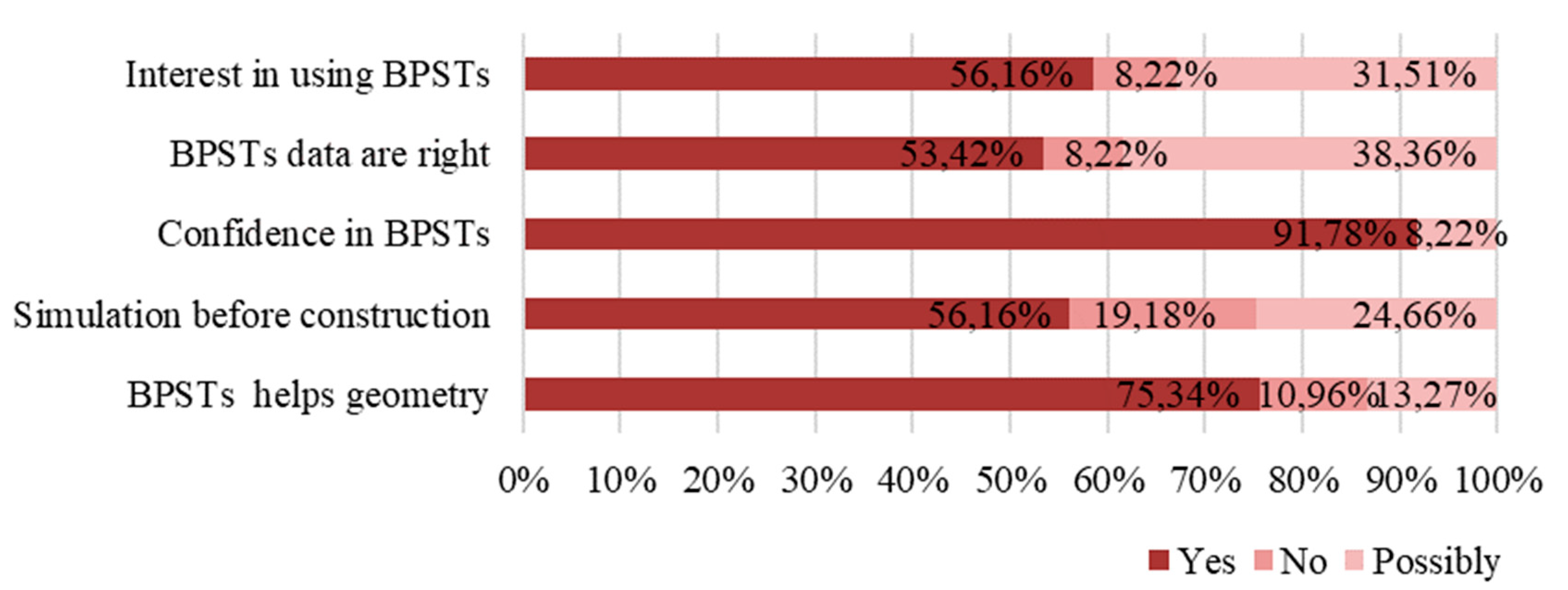

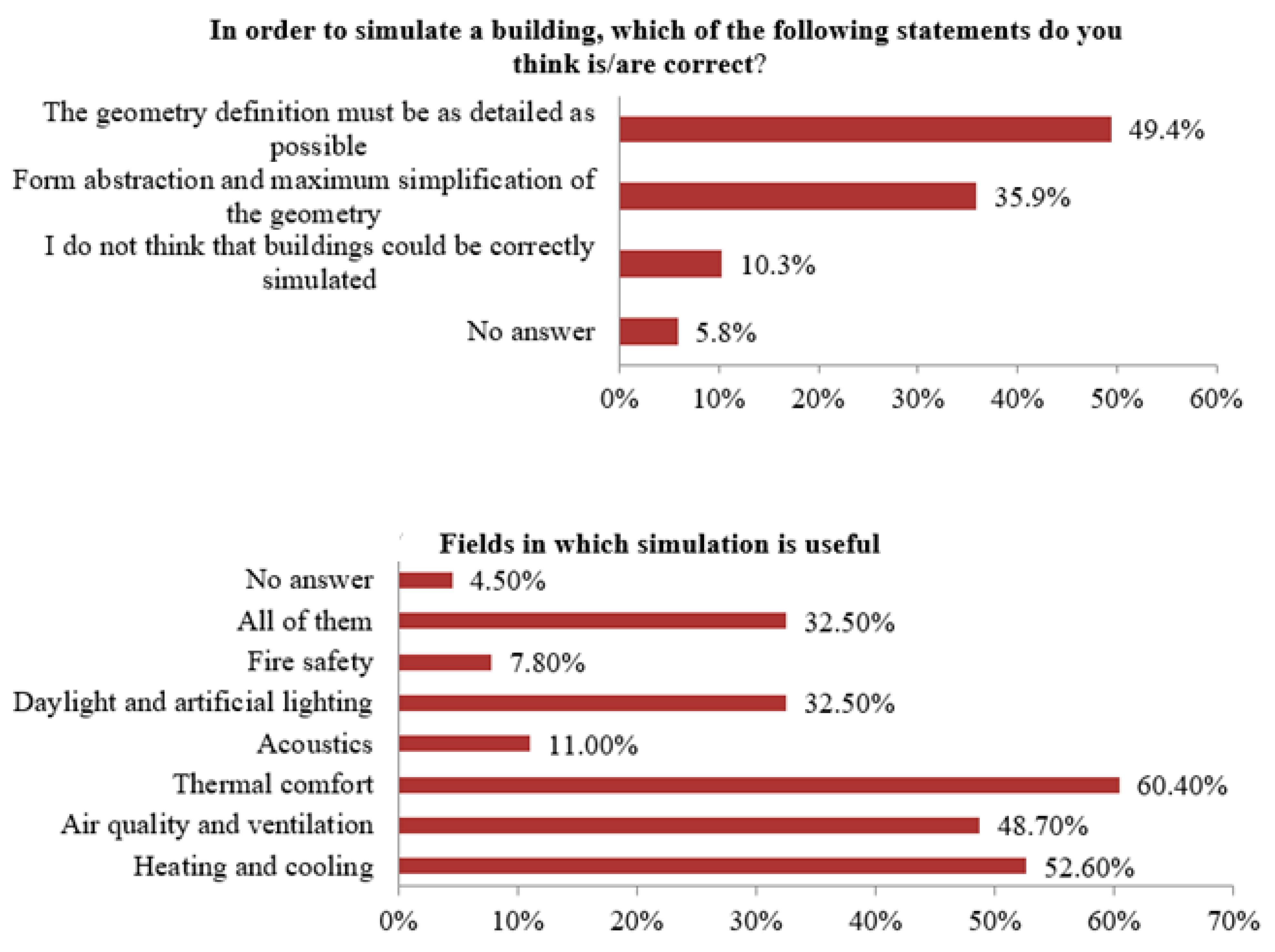
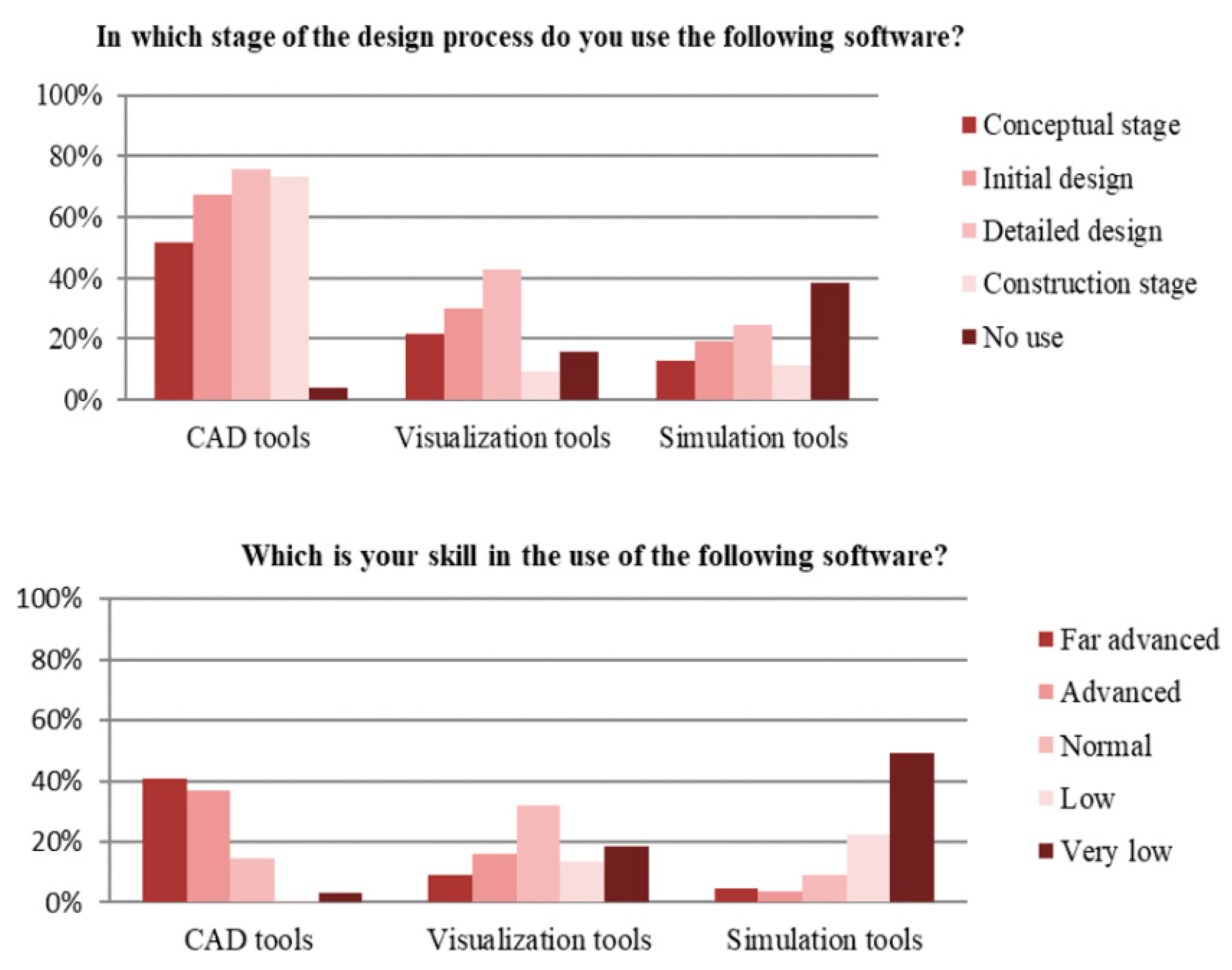
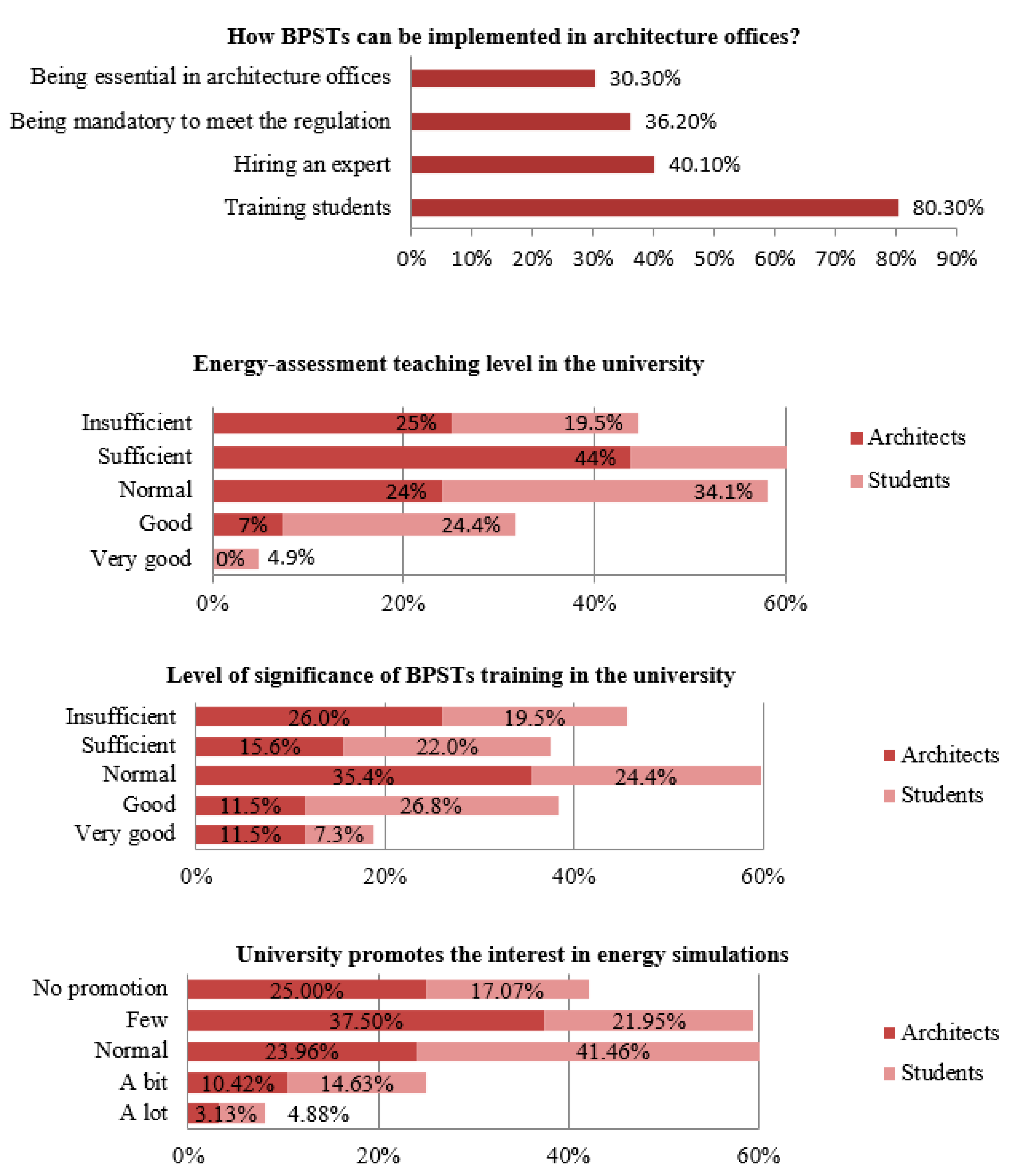
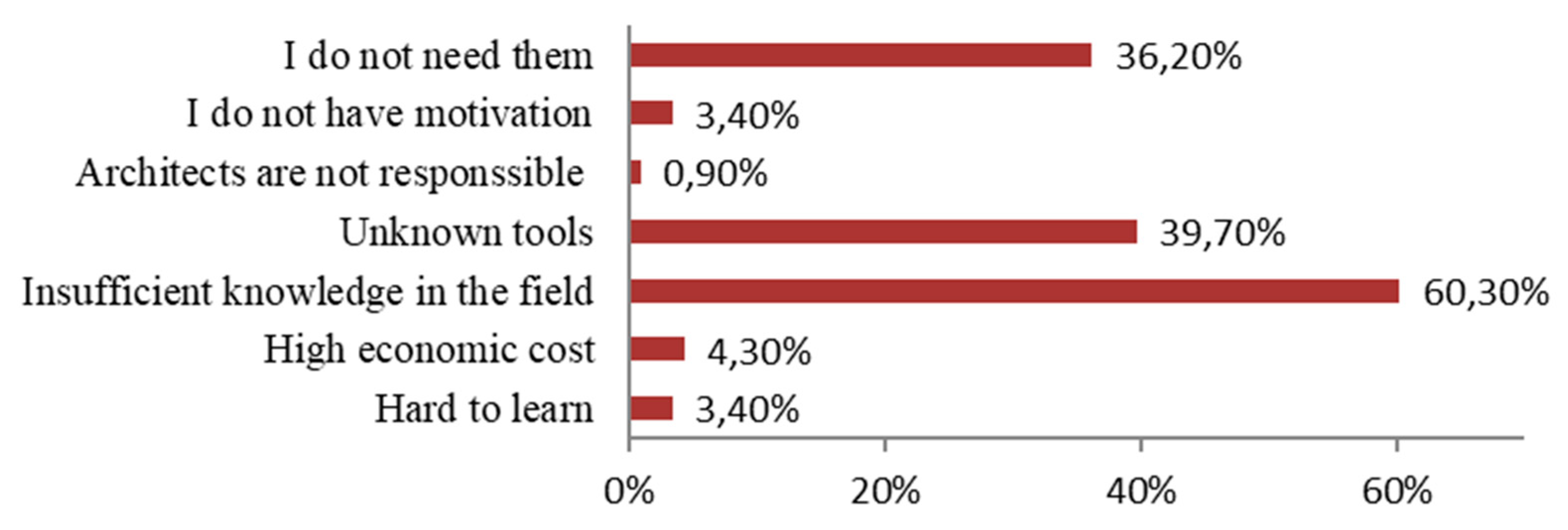
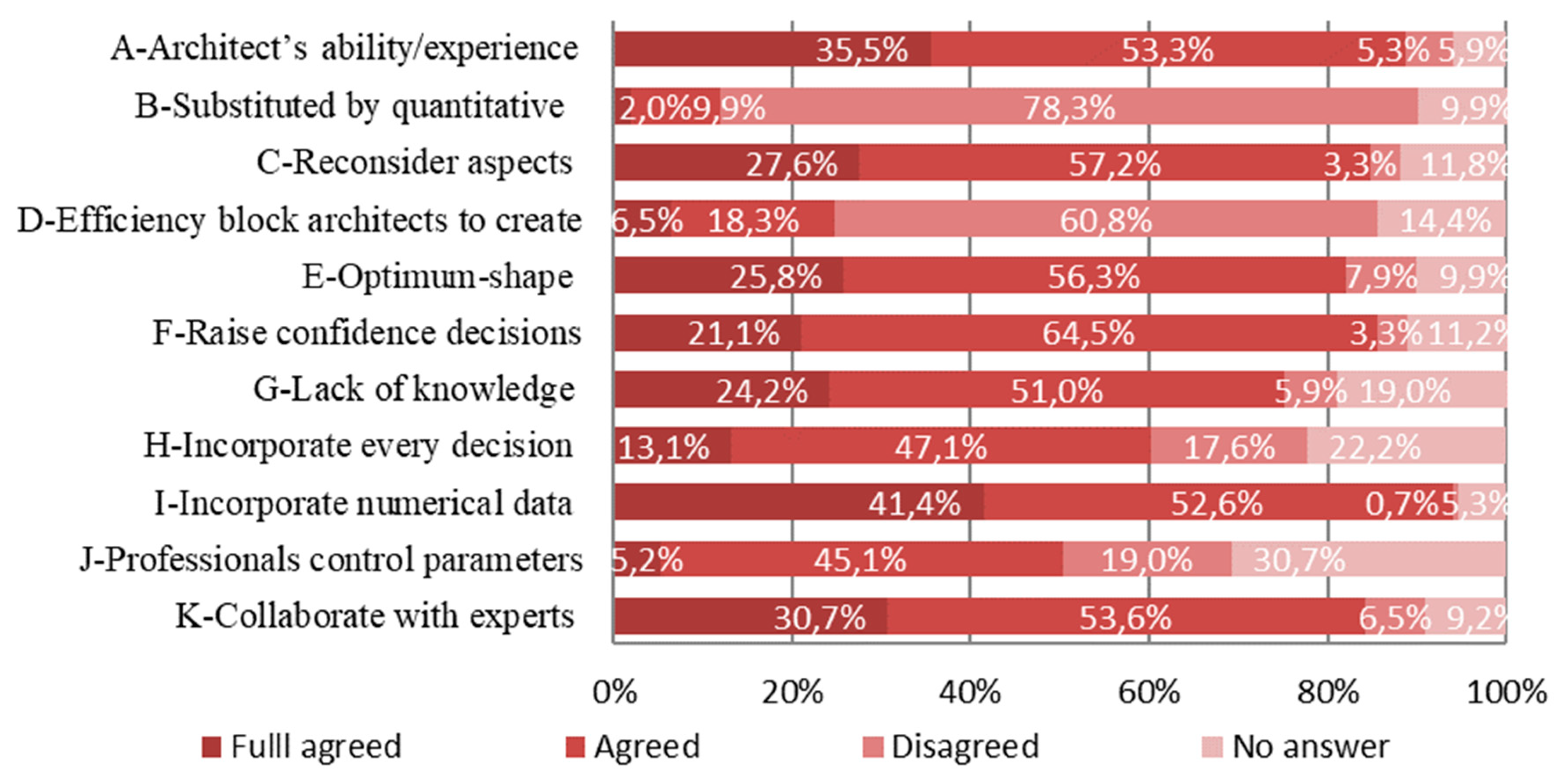

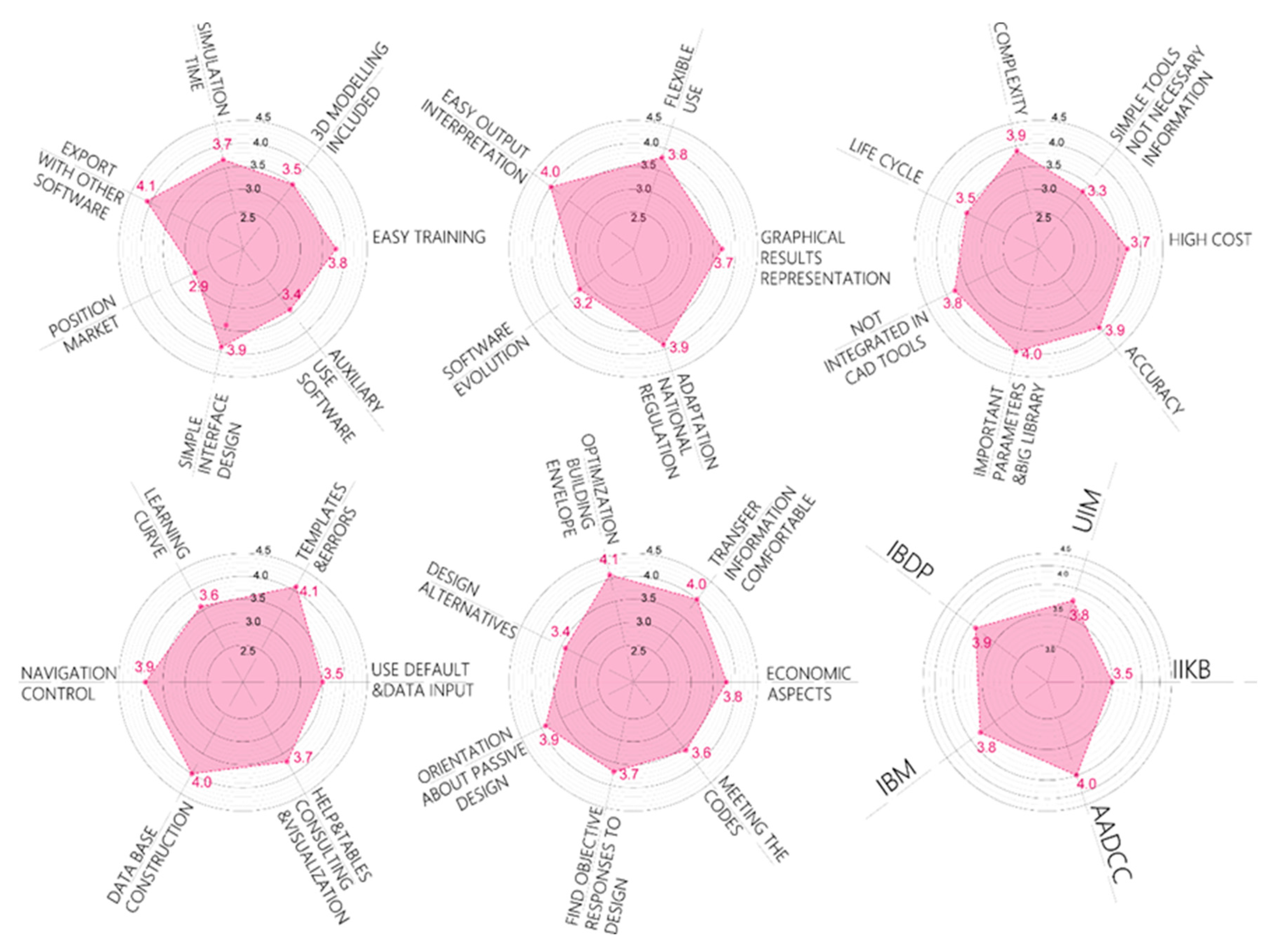
| YES | NO | Possibly | ||
|---|---|---|---|---|
| A | BPSTs are thought to be used by experts who are NOT architects | 33.1% | 18.5% | 48.3% |
| Do you use BPSTs tools at work? | 16.8% | 65.8% | 17.4% | |
| In your university, in Architecture studies, are BPSTs used? | 24.0% | 47.4% | 28.6% | |
| B | Do BPSTs speed up the design stage? | 31.8% | 28.6% | 39.6% |
| Do BPPSTs limit the architect’s creativity in the design stage? | 15.8% | 52.6% | 31.6% | |
| Can simulation software help you to create the geometry? | 63.6% | 11.9% | 24.5% | |
| C | Are the data obtained through simulation software correct? | 45.5% | 7.1% | 47.4% |
| Should BPSTs learning be carried out by a trial-and-error process? | 29.0% | 34.2% | 36.8% | |
| Is building simulation essential before the construction stage? | 58.8% | 19.0% | 22.2% | |
| Is outcomes validation (comparing with real results) necessary? | 87.1% | 2.6% | 10.3% | |
| D | Are BPSTs thought to be used in the NZEB design? | 76.8% | 4.0% | 19.2% |
| Is the architect’s necessities identification vital to ease BPSTs use? | 62.4% | 6.0% | 29.8% | |
| Are you interested in the use of BPSTs in the future? | 63.4% | 5.9% | 30.7% |
 80–100%,
80–100%,  60–80%,
60–80%,  40–60%,
40–60%,  20–40%,
20–40%,  0–20%.
0–20%.Publisher’s Note: MDPI stays neutral with regard to jurisdictional claims in published maps and institutional affiliations. |
© 2022 by the authors. Licensee MDPI, Basel, Switzerland. This article is an open access article distributed under the terms and conditions of the Creative Commons Attribution (CC BY) license (https://creativecommons.org/licenses/by/4.0/).
Share and Cite
Fernandez-Antolin, M.-M.; del Río, J.M.; González-Lezcano, R.A. Building Performance Simulations and Architects against Climate Change and Energy Resource Scarcity. Earth 2022, 3, 31-44. https://doi.org/10.3390/earth3010003
Fernandez-Antolin M-M, del Río JM, González-Lezcano RA. Building Performance Simulations and Architects against Climate Change and Energy Resource Scarcity. Earth. 2022; 3(1):31-44. https://doi.org/10.3390/earth3010003
Chicago/Turabian StyleFernandez-Antolin, Maria-Mar, José Manuel del Río, and Roberto Alonso González-Lezcano. 2022. "Building Performance Simulations and Architects against Climate Change and Energy Resource Scarcity" Earth 3, no. 1: 31-44. https://doi.org/10.3390/earth3010003
APA StyleFernandez-Antolin, M.-M., del Río, J. M., & González-Lezcano, R. A. (2022). Building Performance Simulations and Architects against Climate Change and Energy Resource Scarcity. Earth, 3(1), 31-44. https://doi.org/10.3390/earth3010003








